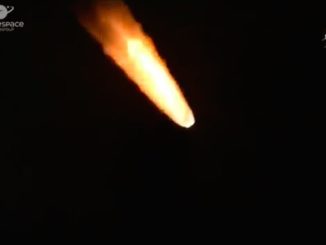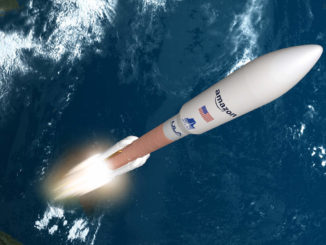
SpaceX’s Crew Dragon spacecraft will likely return to Earth in August to wrap up a test flight to the International Space Station with NASA astronauts Doug Hurley and Bob Behnken, a senior space agency official said Tuesday.
The exact schedule for Hurley and Behnken’s return to Earth will hinge on several factors, such as the performance of their Crew Dragon spaceship, the progress of their work on the space station, and weather conditions in the capsule’s landing zones in the Atlantic Ocean and the Gulf of Mexico, according to Ken Bowersox, the acting associate administrator for NASA’s human exploration and operations mission directorate.
Bowersox said Tuesday that the Crew Dragon’s Demo-2 mission — the first SpaceX mission to carry astronauts — is proceeding as planned, and the crew capsule is performing well since its launch on a Falcon 9 rocket May 30 from the Kennedy Space Center and docking with the space station one day later.
The successful liftoff of the Crew Dragon marked the end of a nearly nine-year gap in launches of astronauts into orbit from U.S. soil following the retirement of the space shuttle in 2011.
Before the launch, NASA officials said the Crew Dragon test flight could last from one to four months, depending on a range of technical and weather factors.
“We didn’t prescribe the length of the Demo-2 mission until we got the crew on orbit and we could see the performance of the Dragon,” Bowersox said Tuesday. “The Dragon is doing very well, so we think it’s reasonable for the crew to stay up there a month or two. The actual details are still being worked out.”
Bowersox took over as acting head of NASA’s human spaceflight efforts last month after the abrupt resignation of Doug Loverro, who served in the role for six months before leaving the agency. Industry sources have said Loverro broke NASA procurement rules during a contract competition earlier this year for federal funding to support the development of new human-rated landers to carry astronauts to the lunar surface.
The Crew Dragon spacecraft that launched with Hurley and Behnken was certified to fly in space for up to four months. The limiting factor on the spacecraft’s endurance is the degradation of the ship’s power-generating solar arrays in the harsh environment of low Earth orbit.
NASA is now looking at bringing Hurley and Behnken back to Earth in late July or some time in August.
Bowersox discussed the plans Tuesday in a briefing during a joint meeting of the National Academies of Sciences, Engineering and Medicine’s Space Studies Board and the Aeronautics and Space Engineering Board.
Behnken is expected to perform at least two spacewalks in late June and early July with space station commander Chris Cassidy, who launched in April on a Russian Soyuz spacecraft. The duo will replace batteries on the far starboard end of the space station’s solar power truss, installing fresh power packs delivered by a Japanese HTV cargo craft last month.
Hurley will operate the space station’s Canadian-built robotic arm during the spacewalks. The arrival of Hurley and Behnken on May 31 ended a six-week period when Cassidy was the only U.S. astronaut on the space station, limiting the crew’s capability to perform experiments, repairs and other required maintenance activities.
“It is very likely that by the end of July, we will have conducted some spacewalks with Chris Cassidy and Bob Behnken, replaced some batteries on the ISS, and we’ll — about two months from now — start thinking about bringing Bob and Doug home,” said Bowersox, a former astronaut and SpaceX executive. “We’d like to get them home some time in August.”
But if weather conditions look favorable, NASA and SpaceX might elect to have the Crew Dragon undock from the station and return to Earth before the end of July, sources said.

Alongside their work to assist Cassidy with regular space station operations, Hurley and Behnken are also helping SpaceX ground teams continue their assessment of the Crew Dragon’s performance. Mission controllers planned to place the Dragon capsule into a hibernation mode, then wake up the ship’s systems to verify the spacecraft can perform its role as a quick-response lifeboat to scurry astronauts back to Earth in the event of an emergency.
Mission managers are also checking data to monitor the status of the solar arrays.
Bowersox said strict wind limits for the Crew Dragon spacecraft flying the Demo-2 mission — named “Endeavour” by Hurley and Behnken — will also come into play as NASA and SpaceX plan the return schedule. In some cases, the wind limit for splashdown could be as low as 9 knots.
“The Demo-2 vehicle has a little bit tighter restrictions on its landing wind requirements, so we’ll need to provide extra lead time for the weather possibilities, but I think it will all work out in August,” Bowersox said. “August is often a light wind month in the parts of the Gulf (of Mexico) and the east coast of Florida that we’re looking at landing, so I think we’ll be able to find a good opportunity in there.”
But officials have not set a target date for the landing. That will wait until later in the mission, once Behnken and Cassidy complete their spacewalks.
“We don’t want to try to pin things down to too hard of a date or too hard of a time,” Bowersox said. “We want to pick the conditions that are right for this first return of the Crew Dragon with crew on-board.”
A few hours after departing the space station, the Crew Dragon will fire its Draco thrusters for a braking burn and re-enter the atmosphere, targeting a parachute-assisted splashdown at sea. The landing zones are located roughly 24 nautical miles, or 27 statute miles, off the east coast of Florida, with a backup site in the Gulf of Mexico south of Pensacola.
The Demo-2 test flight is a precursor to operational crew rotation missions to the space station using the Crew Dragon spacecraft. The first of the operational Crew Dragon missions, known as Crew-1, is scheduled for launch no earlier than Aug. 30 from the Kennedy Space Center.
NASA has ordered six crew rotation flights on the Crew Dragon spacecraft through 2024, each carrying four astronauts to and from the space station on expeditions lasting as long as 210 days. SpaceX also has agreements with Axiom Space and Space Adventures, two commercial space companies, to fly private citizens into orbit on shorter-duration Crew Dragon missions beginning as soon as late 2021.
SpaceX developed the Crew Dragon under contract to NASA, but the company is free to use the spacecraft for commercial flights without NASA involvement.
NASA has a similar contract with Boeing for development of the Starliner crew capsule, which has yet to fly with astronauts. An unpiloted Starliner test flight was cut short before docking with the space station in December, and Boeing plans to fly a second demonstration mission later this year before a test flight with a crew on-board in early 2021.
Steve Stich, deputy manager of NASA’s commercial crew program, said May 31 that space agency managers will evaluate the readiness of the next Crew Dragon spacecraft — for the Crew-1 mission — before deciding when to bring Hurley and Behnken home.
“Not only are we looking at this particular vehicle, we’re also looking ahead to Crew-1,” Stich said. “That’s an important mission for us. It has four crew (members). It really is what commercial crew is about — having the vehicle ready to do these increment missions … Right now, it’s targeting toward being launch-ready at the end of August timeframe. So we’ll just kind of continue to look at this vehicle. Is it performing well? We’ll look at the readiness of that vehicle, and in a month or so, we’ll be able to make a decision as to how long to keep this vehicle in orbit.”
NASA astronauts Mike Hopkins, Victor Glover, Shannon Walker, and Japanese astronaut Soichi Noguchi are training for the Crew-1 mission. The Crew-1 flight will only launch after the return of the Demo-2 mission, and a subsequent review of data from the Crew Dragon test flight.
While the spacecraft for the Demo-2 mission came with a four-month certified mission lifetime, the Dragon for the Crew-1 flight will be certified for a full-duration 210-day mission, according to NASA.
Stich said there are several modifications to the capsule SpaceX is building for the Crew-1 mission, although major components such as the capsule’s life support system and guidance, navigation and control systems are largely unchanged.
“The Crew-1 vehicle can land in a little bit higher wind state,” Stich said. SpaceX has changed some of the outer composite panels to make that a little stronger.”
“It also has the capability not only dock to the forward port of the space station, but it can go to the zenith (space-facing) port as well, so it has that capability, and it has a couple other features,” Stich said.
The space station has two docking ports outfitted to receive Crew Dragon and Starliner spacecraft. Once the Crew Dragon and Starliner vehicles are operational, NASA expects both ports will be used simultaneously to accommodate visiting crew and cargo ships.
Email the author.
Follow Stephen Clark on Twitter: @StephenClark1.



